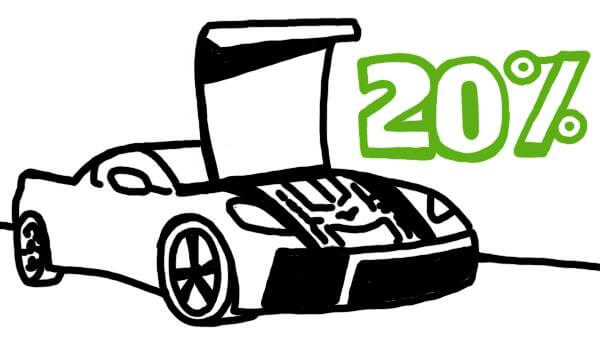Often when TruScribe produces a whiteboard video, we’re asked by clients about our use of color. Do we use many colors? Why is there so much black and white? And if we only use one color, well… why?
First, the amount of colors a client wants in their whiteboard video is up to them. A good whiteboard video production company should always meet its clients’ needs. So if the request is for several colors, then several colors should be reflected in their videos.
When it comes to recommendations, however, a good whiteboard video production company should also have some sage advice when it comes to use of color. That advice almost always involves using only one color—an accent color.
What makes an accent color, as opposed to a regular color?
An accent color is a color that not only stands out against a background of black and white, but is employed purposefully wherever it appears.
Drawing elements in an accent color marks them as the most important parts of the frame.
Once synchronized with a voiced script, an accent color can do wonders to reinforce the crucial elements of script messaging. In other words, an accent color drives engagement with an element of the visuals. And the audio/visual synchronization drives retention of the message.
For example, if the script reads “This new fuel-efficient engine can save the average driver 20% of their fuel expenses per year,” we can expect to see a car, with the engine prominently displayed. We can probably also expect the “20%” mentioned in the script to appear onscreen as the narrator reads the figure.
So, where does the accent color go in this scene? Let’s walk through the options.
Should it be the car? Probably not, for a number of reasons. The first and most salient reason is that this script isn’t about the car—in fact, in this moment, it’s not really even about the engine. It’s about the savings, which are represented by the 20%.
Why not color all of the elements in the video?
The other reason to avoid coloring the car comes from the science of engagement, as well as retention. When the brain is confronted with visual and auditory information, it will almost always focus on the visual information—and ignore auditory information if necessary.
This means that any image that does not line up with the script will take away from the script’s message. The word “car” is not in the script, so its presence is really only superficially necessary. The car contextualizes the engine—and putting it in an accent color will further distract the audience from the message.
Now, the engine—should it be in our accent color? It’s a slightly better fit, since our video is about the engine; however, let’s think about the text. The script segment we’re working with implies that the engine has already been introduced. This matters because the accent color was likely used in that introduction. And the audience already knows that the engine is the principal focus of the script.
Use the Accent Color for the Most Important Information
The new (and most important) information in this sentence is the 20% savings. And you guessed it—it’s what we’re going to be drawing in our accent color. The savings are the focus of this portion of the script, so we’ll want viewers’ eyes to be drawn to the number. By drawing it in the accent color, the viewer’s engagement is cemented even further. The script’s message will almost certainly be retained.
So Why Only One Accent Color?
That brings us to the title of this article: if an accent color can be so effective at driving engagement and promoting retention, why not use a variety of them? Why does the term inherently bias towards one, instead of several?
The first reason is distraction.
While one accent color pulls the eye to the precise point in frame you need emphasized, several can pull the eye all around the frame. This problematizes the emphasis effect of the accent color so thoroughly that they essentially become ‘just’ colors—attractive, interesting, but absent their focal power.
Flowing from this line of thought is a similar concept:
If everything receives emphasis, nothing does.
Suppose you employ red, blue, and yellow in drawing three elements that are crucial to your message. The problem is that, with three accent colors, the eye doesn’t know which one is most important. You’ve separated out three elements and implicitly urged attention towards them, but there’s no indication of which matters most.
Against black and white, the color red clearly delineates the most important element; against black, white, blue, and yellow, it doesn’t have this status.
The final reason to prefer a single accent color over several is that a single accent color can have associative power as well.
In other words, if your company’s logo and product are always drawn in your green accent color, it forms not only a focal point but an association between color and brand in the viewer’s mind.
Add another color to the above scenario that’s used more loosely, and the associative quality of a single accent color deteriorates. Use purple to show a customer in one scene and then for a piece of machinery in the next, and your viewer won’t know what purple “means” in the same way they’ll know what green means when it’s used consistently and singularly.
Hand-drawn black and white images are high-contrast, easily understood reinforcement of your message. Your accent color adds an even stronger level of reinforcement by ensuring the viewer’s eye is focused on the right element of the message—the element being drawn in concert with the voiced script.
By maintaining a single accent color, you maintain its focal power, prevent distraction, and create associations that multiple colors will not be able to create. A single accent color is not a limitation—it’s the optimal use of color in a whiteboard video, and an effective way to increase engagement and retention rates.

